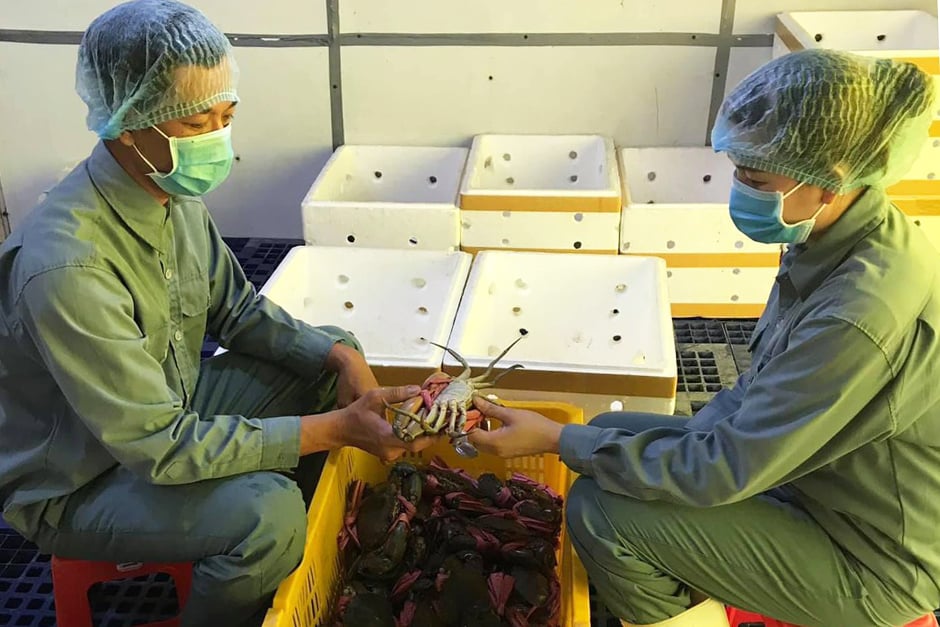November 27, 2025 | 21:46 GMT +7
November 27, 2025 | 21:46 GMT +7
Hotline: 0913.378.918
November 27, 2025 | 21:46 GMT +7
Hotline: 0913.378.918

Ca Mau crab needs to enhance its brand image in international markets. Photo: Trong Linh.
According to a report by Ca Mau Provincial People's Committee, Ca Mau sea crab is one of the key aquacultural products responsible for restructuring of the agricultural sector. Ca Mau province has an annual crab farming area of over 250,000 hectares, and an estimated output of at least 25,000 tons.
With this output, the commercial value of Ca Mau crab can reach over VND 10,000 billion a year, which contributes greatly to raising income for aquaculture farmers (second only to shrimp products). Thanks to its aforementioned strengths, Ca Mau province has the largest crab production capacity in Vietnam.
Several production areas in Ca Mau province have been granted protection of geographical indications and protection of collective trademarks to further strengthen the management, control and promotion of its crab products. These contributing to improving the quality of products and services. high value local crab products.
During a working session with the Ministry of Agriculture and Rural Development, Mr. Le Van Su, Vice Chairman of the Provincial People's Committee reported that Ca Mau crab products are mainly exported to the Chinese market. However, they are susceptible to price manipulation, and production has not been organized in a sustainable manner.

Mr. Le Van Su, Vice Chairman of the Provincial People's Committee, reported that Ca Mau crab products are susceptible to price manipulation, and production has not been organized in a sustainable manner. Photo: Tung Dinh.
On the other hand, the Viettel Post Corporation has conducted substantial research and study on the Chinese market, particularly in areas where Ca Mau crabs are consumed.
Subsequently, Ca Mau Provincial People's Committee held a working session with relevant provincial departments, agencies, Viettel Group and Viettel Post on May 10 to discuss the plan to reorganize production and export of Ca Mau crab to the Chinese market as well as other countries in the region.
Mr. Dinh Thanh Son, a representative from Viettel Post, reported that the Chinese market has a high demand for Ca Mau crab products. However, the Ca Mau crab brand has not made a significant impact on large seafood distribution centers in Guangxi and Guangzhou provinces.
Another challenge, according to Mr. Son, is the transportation and quality assurance for crab products when they arrive at the Chinese market.
Viettel Post suggested the Ministry of Agriculture and Rural Development to issue identifying codes for each individual crab in addition to existing geographical indicationsto determine the origin and establish a brand.
Furthermore, Viettel Post has coordinated with Chinese partners to build an extensive supply chain across the country. This supply chain utilizes multiple e-commerce platforms such as JD, Alibaba or livestreams.
Therefore, Ca Mau province and Viettel Post requested the Ministry of Agriculture and Rural Development to support a project to reorganize production and officially export Ca Mau crab products to the Chinese and other countries in the region.
According to Mr. Ngo Hong Phong, Deputy Director of the Department of Quality, Processing and Market Development under Ministry of Agriculture and Rural Development, numerous Vietnam's aquacultural products, including Ca Mau crab, have been officially exported to China.
These products must satisfy two requirements. Namely, the product smust be manufactured and packaged at facilities approved by the Chinese government; and each shipment will be inspected and certified before exporting.
"Currently, the Chinese government has sanctioned 880 seafood processing facilities in Vietnam; 45 of which are crab production units and 5 are in Ca Mau", said Mr. Ngo Hong Phong.
In order to develop this product sustainably, Mr. Phong suggested stakeholders to develop a master plan, including a system of geographical indications, brand promotion, and various logistical improvements.

Inside a crab packaging facility in Ca Mau. Photo: Trong Linh.
Mr. Ngo The Hien, Deputy Director of the Department of Planning under Ministry of Agriculture and Rural Development highlighted the possibility of a traceability system and anti-counterfeiting stamps for Ca Mau crab products. Anti-counterfeiting stamps are considered to be an effective solutions to enhance the Ca Mau crab's brand because they are inexpensive (costing only 200 VND per stamp) while providing detailed information.
Subsequently, Minister Le Minh Hoan emphasized the need to standardize the Ca Mau crab industry and consolidate these standards with seed, nurturing, harvesting, and packing procedures.
This task was assigned to the Directorate of Fisheries, with the motto: “Enhancing the Ca Mau crab's brand for the market of 100 million Vietnamese people before exporting worldwide."
The Minister said that it is necessary to expand further into the Chinese domestic market. Accordingly, the Department of Quality, Processing and Market Development was assigned to coordinate with Ca Mau province in implementing this approach.
Translated by Nguyen Hai Long

(VAN) China’s cooking oil is suddenly flooding into India. It all comes down to a soybean surplus that Beijing doesn’t quite know what to do with.

(VAN) An Giang promotes supply-demand connections, standardizes quality and builds value chains, creating a foundation for sustainable bird’s nest development and aiming to expand exports.
/2025/11/24/5339-4-nongnghiep-075331.jpg)
(VAN) Recently, the conference on 'Sustainable Fisheries Linkage Chain - Tilapia for Export' took place in Tien Hai commune, Hung Yen province.
/2025/11/21/4309-2-153400_128.jpg)
(VAN) Green and low-emission rice is paving the way for Vietnamese rice to enter high-end markets, marking the beginning of a transformation journey toward greening and elevating the national rice brand.

(VAN) ‘Right to Win’ outlines a national action plan that shapes a new vision for Viet Nam’s agriculture in an era of renewal and global integration.

(VAN) Lam Dong’s farmed sturgeon output this year is expected to reach 2,300 tons, worth VND 450 billion, affirming the brand’s position on the market.

(VAN) A surge in Ukrainian egg exports, largely driven by soaring sales to the UK over the last few years, has notably pushed up egg prices on the domestic market.